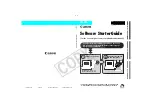
Glossary
Glossary-30
PortMaster Configuration Guide
route reflection
In BGP, a method for maintaining path and attribute information across an autonomous
system, while avoiding the overhead of having all peers within an autonomous system
fully communicate to—be fully meshed with—each other. To reduce the number of links,
all internal peers are divided into clusters, each of which has one or more route reflectors.
A route received by a route reflector from an internal peer is transmitted to its clients,
which are the other peers in the cluster that are not route reflectors. Route reflection
requires that all internal peers use identical policies.
Confederations are another way to avoid configuring a fully meshed set of peers in a
single autonomous system. In contrast to route reflection clusters, confederations require
all routers in the autonomous system to operate as confederation members. However,
confederations provide a finer control of routing within the autonomous system by
allowing for policy changes across confederation boundaries. See also
cluster
;
cluster
ID
;
confederation
;
route reflector
.
route reflector
A router configured to transmit routes received from internal BGP peers to one or more
other internal peers within its same cluster. These peers are called the route reflector’s
clients
. See also
cluster
;
cluster ID
;
route reflection
.
router ID
One of the interface addresses configured on a BGP speaker. The router ID is chosen as
the address that uniquely identifies the BGP speaker on the Internet.
Routing Information Protocol
See
RIP
.
routing table
A database of routes to particular network destinations, stored on a router or other
device. The routing table stored on the PortMaster contains the following information for
each route: IP address and netmask length of the destination, IP address of the gateway,
source of the route (if any), type of route, hop-count metric, and PortMaster interface
used to forward packets along the route.
RS-232 interface
A standard for data communication using serial data and control signals.
runt packet
A packet with a frame size between 8 and 63 bytes with frame check sequence (FCS) or
alignment errors. The runt packet is presumed to be a fragment resulting from a collision.
Содержание PortMaster
Страница 16: ...Contents xvi Configuration Guide for PortMaster Products...
Страница 26: ...Subscribing to PortMaster Mailing Lists xxvi PortMaster Configuration Guide...
Страница 32: ...Basic Configuration Steps 1 6 PortMaster Configuration Guide...
Страница 114: ...Configuring WAN Port Settings 6 12 PortMaster Configuration Guide...
Страница 128: ...Configuring Login Users 7 14 PortMaster Configuration Guide...
Страница 158: ...Restricting User Access 9 16 PortMaster Configuration Guide...
Страница 168: ...Configuring Ports for Modem Use 10 10 PortMaster Configuration Guide...
Страница 222: ...Frame Relay Subinterfaces 13 16 PortMaster Configuration Guide...
Страница 236: ...Troubleshooting a Synchronous V 25bis Connection 14 14 PortMaster Configuration Guide...
Страница 252: ...Using ISDN for On Demand Connections 15 16 PortMaster Configuration Guide...
Страница 264: ...Using ISDN for Internet Connections 16 12 PortMaster Configuration Guide...
Страница 276: ...Configuration Steps for Dial In Access 17 12 PortMaster Configuration Guide...
Страница 286: ...Configuration Steps for Shared Device Access 18 10 PortMaster Configuration Guide...
Страница 296: ...Troubleshooting a Leased Line Connection 19 10 PortMaster Configuration Guide...
Страница 310: ...B 4 PortMaster Configuration Guide...
Страница 352: ...Command Index Command Index 6 PortMaster Configuration Guide...
















































